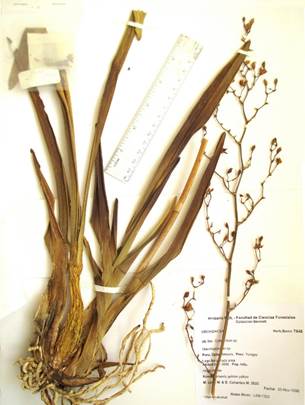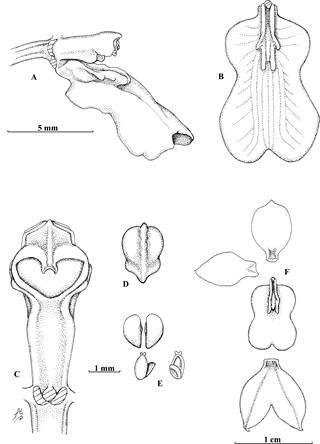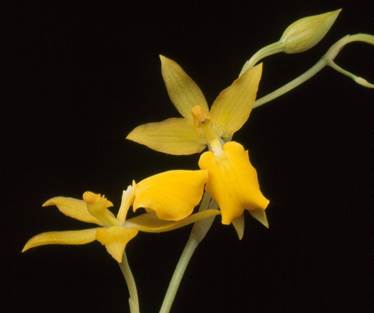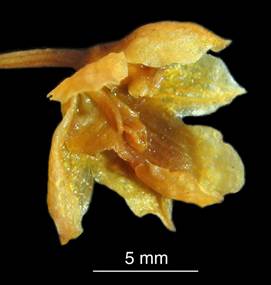Introduction
While exploring the western slopes of the Peruvian Andes the authors have observed that the climate there is markedly less humid than on the eastern slopes. This appears to be the effect from the Humboldt Current that brings cold water from the Antarctic region up along the Peruvian coast, which in turn produces less evaporation of water. This climatologic and hydrologic fact simply means less rain over the coastal area. Being more densely populated than the eastern slopes, it also means a heavier toll on existing fresh water sources and on other natural resources such as original forests. Slash and burn techniques to clear land for pastures, and mining operations are other human activities that disturb the natural orders. This has created a landscape commonly dominated by shrubs and grasslands. The orchid diversity in these plant communities therefore seem to be relatively poor, according to the authors’ observations. Species of the Oncidiinae appear to be scarce in this region in contrast to the eastern slopes of the Peruvian Andes where this subtribe is highly diverse. At elevations above 3000 m only two Oncidiinae species have been currently recorded from the central-northern highlands of Peru (Departments of Ancash and La Libertad): Trichoceros tupaipi Rchb.f. and Cyrtochilum cochleatum (Lindl.) Dalström (Fig. 1) (Trujillo 2012). This latter species has been misidentified by several authors and reported as “Odontoglossum mystacinum (Lindl.) Lindl.” (Weberbauer 1945), “O. rigidum Lindl.”, (Kolff & Kolff 1997; Smith 1988) and C. aureum (Lindl.) Senghas (Trujillo 2012, 2013). The C. aureum complex consists of four hitherto described species: C. aureum, C. cochleatum, C. mystacinum, C. rigidum (Lindl,) Dalström (Dalström 2013), and one undescribed species from the Department of Huanuco (in cultivation by the Perúflora nursery). During a recent revision of the Cyrtochilum specimens of the David Bennett Collection kept at the herbarium of the National Agrarian University La Molina in Lima (MOL), a new species with golden yellow flowers from the highlands of Ancash was found that superficially resembles the members of the C. aureum complex but differs in not having distinct lacerate column wings and by having a distinctly pandurate lip lamina, and is described here.
Taxonomic treatment
Cyrtochilum panduratum Dalström & D.Trujillo, sp. nov. (Fig. 2-4).
TYPE: Peru. Ancash: Yungay; Huascarán National Park, Lago Llanganuco area on rocky slopes, 3800 m, 20 Nov. 1998, M. León & B. Collantes 2825 (Herbarium Bennettianum 7848) (holotype: MOL).
Diagnosis: Cyrtochilum panduratum is distinguished from the species in the superficially similar C. aureum complex by the combination of the wingless column and the distinctly pandurate lip lamina.
Terrestrial or lithophytic herb. Roots thick, ca. 3-4 mm in diameter. Pseudobulbs caespitose, ovoid elongate, ca. 9 × 3 cm, bifoliate or trifoliate, surrounded basally by 5 to 6 distichous sheaths, the uppermost foliaceous. Leaves subpetiolate, conduplicate, elliptic to obovate-lanceolate, obtuse apiculate,19-28 × 1.5-2.0 cm. Inflorescence erect, an almost straight to indistinctly flexuous panicle with many widely spaced, indistinctly flexuous 2-10 cm long side-branches, total length 118 cm long [according to the original collector’s notes]. Inflorescence bracts and floral bracts similar, scale-like, appressed, acute, 2-15 mm long. Pedicel with ovary 8-15 mm long. Flowers golden yellow; dorsal sepal unguiculate, obovate, indistinctly canaliculate, apiculate with 5 veins, ca. 8 × 5 mm; lateral sepals fused for ca. 1/3 of their length then spreading, unguiculate, elliptic to indistinctly ovate and slightly oblique, indistinctly canaliculate, apiculate, with 5 veins, ca. 10 × 4 mm; petals shortly unguiculate, obliquely ovate, ca. 7 × 4.5-5.0 mm, with 5 veins; lip rigidly attached to the base of the column, unguiculate, broadly cuneate, pandurate, retuse, ca. 10-11 × 6 mm; callus with a fleshy elevated central ridge emerging at the base of the lip, extending to the constricted part of the lip lamina, consisting of a pair of parallel basal ridges, diverging into spreading rounded angles, with an intermediate pair of blunt and fleshy angles apically, and with a smaller, blunt angle in between, ca. 4 mm long. Column clavate, straight, dorsally ridged, ventrally canaliculated with distinct apical angles below the stigmatic surface, and with a pair of apical more or less rounded wings, ca. 4 mm long; anther cap campanulate with a dorsal ridge, shortly rostrate; pollinarium of two obovoid, cleft/folded pollinia on a ca. 1 mm long ovate and strap-like stipe, longitudinally indistinctly revolute along the edges, on a pulvinate viscidium.

Photo by D. Trujillo.
Figure 2 Holotype of Cyrtochilum panduratum Dalström & D.Trujillo, M. León M. & B. Collantes M. 2825 (MOL).

Drawn from the holotype by Stig Dalström.
Figure 3 Cyrtochilum panduratum. A. Column and lip lateral view. B. Lip frontal view. C. Column ventral view. D. Anther cap. E. Pollinarium. F. Dissected flower.
Paratype: No additional material seen.
Distribution: Cyrtochilum panduratum is only known from the type location, at high elevation rocky slopes in the area surrounding the Llanganuco lakes located in the Huascarán National Park, Department of Ancash, Peru.
Etymology: Named in reference to the pandurate lip lamina.
From a floral morphology aspect Cyrtochilum panduratum does not seem to have any close relatives that it can be confused with. The combination of the distinctly pandurate lip lamina with a front lobe wider than the rounded basal lobes combined, together with the partially fused lateral sepals easily distinguish it from other yellow small-flowered species such as C. longipes Rchb.f. and C. soennemarkii Dalström, which have basal lobes wider than the front lobe. In overall morphological features Cyrtochilum panduratum is superficially similar to the yellow-colored C. cochleatum, C. mystacinum and C. rigidum but differs in not having any kind of apical column wings, versus large, lacerate and downward directed wings for the latter species.












 uBio
uBio 



